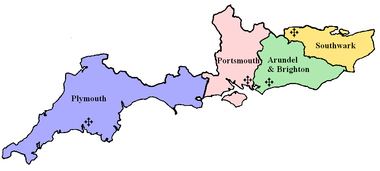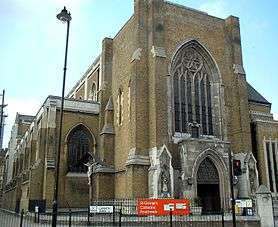Roman Catholic Archdiocese of Southwark
| Archdiocese of Southwark Archidioecesis Southvarcensis | |
|---|---|
 Coat of arms of the Archdiocese of Southwark | |
| Location | |
| Country | England |
| Territory | The London boroughs south of the Thames, the county of Kent and the Medway Unitary Authority |
| Ecclesiastical province | Southwark |
| Metropolitan | Southwark |
| Deaneries | 20 |
| Statistics | |
| Area | 3,000 km2 (1,200 sq mi) |
| Population - Total - Catholics |
(as of 2010) 4,444,065 383,265 (8.6%) |
| Parishes | 181 |
| Information | |
| Denomination | Roman Catholic |
| Rite | Latin Rite |
| Established | 29 September 1850 |
| Cathedral | St George's Cathedral, Southwark |
| Secular priests | 274 |
| Current leadership | |
| Pope | Francis |
| Metropolitan Archbishop | Peter Smith |
| Auxiliary Bishops | |
| Emeritus Bishops |
|
| Map | |
 Dioceses of the Province of Southwark. The Archdiocese of Southwark is the easternmost | |
| Website | |
| rcsouthwark.co.uk | |

The Roman Catholic Archdiocese of Southwark (Br [ˈsʌðɨk])[1] is a Latin Church Roman Catholic archdiocese in England. The archepiscopal see is headed by the Archbishop of Southwark. The archdiocese is part of the Metropolitan Province of Southwark, which covers the South of England. The cathedral church is St George's Cathedral, Southwark.
Location
The archdiocese covers the London boroughs south of the Thames, the county of Kent and the Medway Unitary Authority.
Boundaries
The diocese is divided into three pastoral areas and 20 deaneries, each of which contain a number of parishes:
Kent Pastoral Area: 50 parishes
- Canterbury (7): Ashford; Ashford South; Canterbury; Faversham; Herne Bay; Hersden; Whitstable.
- Chatham (9): Chatham; Gillingham; Parkwood and Wigmore; Rainham; Rochester; Sheppey; Sittingbourne; Strood; Walderslade.
- Dover (8): Buckland; Deal; Dover (including Aylesham); Folkestone; Folkestone West; Hythe; Mongeham and Sandwich.
- Gravesend (7): Dartford; Dartford–St Vincent's; Gravesend; Hartley; Meopham; Northfleet; Swanley.
- Maidstone (7): Bearsted and Harrietsham; Cranbrook; Goudhurst; Maidstone; Maidstone South; Tenterden; West Malling.
- Thanet (4): Birchington and Westgate; Margate and Cliftonville; Broadstairs; Ramsgate and Minster.
- Tunbridge Wells (8): Edenbridge; Paddock Wood; Pembury; Sevenoaks; Southborough; Tonbridge; Tunbridge Wells; Westerham.
South East Pastoral Area: 66 parishes
- Bexley (9): Bexley; Bexleyheath; Blackfen; Bostall Park; Crayford; Erith; Sidcup; Thamesmead South; Welling.
- Bromley (13): Anerley; Beckenham; Biggin Hill; Bromley; Bromley Common; Chislehurst; Chislehurst West; Farnborough; Hayes; Orpington; Petts Wood; St Mary and St Paul's Cray; West Wickham.
- Camberwell (6): Camberwell; Dulwich; Dulwich Wood Park; Nunhead; Peckham; Peckham Rye.
- Greenwich (15): Abbey Wood–St Benet's; Abbey Wood–St David's; Blackheath; Charlton; Eltham; Eltham Well Hall; Greenwich; Greenwich East; Kidbrooke; Mottingham; Plumstead; Plumstead Common; Shooters Hill; Thamesmead Central; Woolwich.
- Lambeth (13): Brixton; Brixton Hill; Clapham; Clapham Park; Italian Mission; Norbury; Norwood West; Herne Hill; Stockwell; Streatham; Streatham Hill; Vauxhall; Waterloo.
- Lewisham (10): Beckenham Hill; Brockley; Catford; Deptford; Downham; Forest Hill; Lee; Lewisham; Sydenham; Sydenham Kirkdale.
South West Pastoral Area: 64 parishes
- Balham (9): Balham; Battersea Park; Battersea West; Clapham Common; Earlsfield; Tooting; Tooting Bec; Wandsworth; Wandsworth East Hill.
- Cathedral (9): Cathedral; Bermondsey–Dockhead; Bermondsey–Melior Street; Bermondsey South; Borough; Kennington Park; Rotherhithe; Surrey Docks; Walworth.
- Croydon (13): Addiscombe; Coulsdon; Croydon South; Croydon West; New Addington; Norwood South; Norwood Upper; Old Coulsdon; Purley; Sanderstead; Selsdon; Thornton Heath; Waddon.
- Kingston (7): Chessington; Kingston; Kingston Hill; New Malden; Norbiton; Surbiton; Tolworth.
- Merton (9): Colliers Wood; Merton; Mitcham; Morden; Pollards Hill; Tooting (Links Road); Wimbledon; Wimbledon Park; Wimbledon South.
- Mortlake (9): Barnes; East Sheen; Ham; Kew Gardens; Mortlake; Putney; Richmond; Roehampton; Wimbledon Common.
- Sutton (8): Carshalton; Carshalton Beeches; Cheam; North Cheam; Sutton; Sutton Green; Wallington; Worcester Park.
History
Southwark was one of the dioceses established at the restoration of Catholic hierarchical structures in 1850 by Pope Pius IX. The areas which now comprise the Diocese of Portsmouth and the Diocese of Arundel and Brighton subsequently separated. The Ecclesiastical Province of Southwark was erected in 1965 by Pope Paul VI, raising the Diocese to archdiocesan status.
Original cathedral
The Papists Act of 1778 brought a certain limited freedom to those of the faith. Priests no longer moved in fear of imprisonment. Roman Catholics could run their own schools and could once more acquire property. In protest against the act, Lord George Gordon, on 2 June 1780, gathered a large crowd in St George's Fields to march on Westminster. Refused a hearing, they became violent and so began a week of burning, plundering and killing in which many Roman Catholic chapels and houses were destroyed. There is a legend that the high altar of the cathedral stands on the spot where the march began.
In 1786 there was only one Roman Catholic chapel in the whole of south London, located at Bermondsey. It was then that the Reverend Thomas Walsh, a Douai priest, for £20 a year hired a room in Bandyleg Walk (near where the Southwark fire station now stands). Within two years, the numbers attending the little chapel had increased so rapidly that a new building became essential. In 1793 a large chapel dedicated to St George was opened in the London Road at a cost of £2,000. It was designed by James Taylor of Weybridge, Surrey. According to tradition it was here that the first High Mass was celebrated in London, outside the chapels of ambassadors, since the time of King James II of England. The occasion was the Solemn Requiem sung for the repose of the soul of Louis XVI of France, who was executed on 21 January 1793.
It was to St George's that the Reverend Thomas Doyle came in 1820, when the congregation stood at around 7,000. He became the first chaplain in 1829, when the Roman Catholic Relief Act 1829 removed nearly all the legal disabilities which Catholics had suffered for 250 years. As Doyle's congregation increased to 15,000 by 1829, the idea grew in his mind of a great church with the dimensions of a long and lofty cathedral. By 1839 enough money had been collected to make a start and the present site in St George's Fields (then an open space) was purchased for £3,200.
Augustus Pugin, the noted architect of the Gothic Revival, was commissioned to design the church. Lack of funds, however, prevented the committee from accepting his first design of a cruciform cathedral on a grand scale and less ambitious plans had to be prepared. Work began on the old cathedral in 1840, the foundation stone being laid on 8 September. The church was solemnly opened by Bishop Nicholas Wiseman (later Cardinal Wiseman) on 4 July 1848. To mark the occasion, Pope Pius IX sent a golden chalice and paten as a gift.
Two years later, Pope Pius restored the English Roman Catholic hierarchy and St George's was chosen as the cathedral church of the new Roman Catholic Diocese of Southwark, which was to cover the whole of southern England. For the next half-century, until the opening of Westminster Cathedral, St George's was the centre of Roman Catholic life in London. Thomas Grant was made the first Roman Catholic Bishop of Southwark; Doyle became the provost and administrator and remained so until his death on 6 June 1879. He is buried in the crypt. The new cathedral was consecrated by Bishop Butt on 7 November 1894 and on that day every year the feast of the dedication of the cathedral is celebrated throughout the diocese.
Archbishop
As of 10 June 2010, the current archbishop is Peter Smith. His predecessor, Kevin McDonald, led the archdiocese until 4 December 2009, when he submitted his resignation in keeping with canon law which provides for the retirement of a diocesan bishop on grounds of ill health or for other grave reasons. There are three auxiliary bishops: Patrick Lynch SS.CC., titular bishop of Castrum; and Paul Hendricks, titular Bishop of Ross and Cromarty; Paul Mason, titular Bishop of Skálaholt. These bishops have particular pastoral responsibility in South East London, South West London and Kent respectively.[2]
Pilgrimage
The Southwark archdiocese makes up part of the Catholic Association Pilgrimage.
Education
The archdiocese is the foundation responsible for over 170 Voluntary Aided and Voluntary Controlled schools in the diocese and is the sponsor of two schools under the English academy programme.
See also
References
- ↑ "Southwark", in The Columbia Lippincott Gazetteer of the World (1952), New York: Columbia University Press.
- ↑ "Welcome to Southwark". www.rcsouthwark.co.uk. Retrieved 2016-11-17.
External links
- Roman Catholic Archdiocese of Southwark
- Parishes of the diocese
- St George's Roman Catholic Cathedral, Southwark
- Diocesan Vocations website

